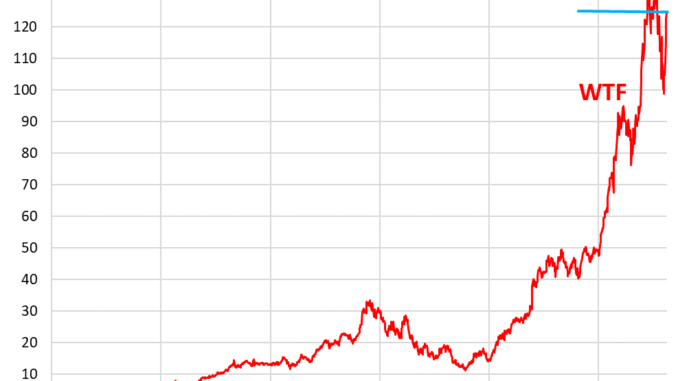
By Wolf Richter for WOLF STREET.
It was a big week for stocks, a huge week for Nvidia (+18.9%) and for Tesla (+8.1%), an even huger seven days for Nvidia (+25.9%), after the battering that they and markets had taken over the prior two weeks. But Alphabet, with the breakup sword hanging over its head, lost more ground during the week.
The Magnificent 7 together – Apple, Microsoft, Nvidia, Alphabet, Amazon, Meta, and Tesla – gained 6.2% during the week and nearly 10% during the last seven trading days. In dollars, that seven-day gain amounted to $1.4 trillion, close to half of what they’d lost since the July 10 peak. The bunch is still down by $1.49 trillion (-8.8%) since July 10. With a combined market cap of $15.5 trillion, these seven stocks totally dominate the S&P 500.
Much of the heavy lifting of these mindboggling amounts was done in two trading days, Tuesday and Thursday (data via YCharts):
Nvidia [NVDA] shot up by 25.9% over the past seven trading days, or by $631 billion, a majestic bounce and a phenomenal amount in dollar terms. It’s still down 7.7% from its all-time high. We’re now waiting to turn this into our triple-WTF Chart of the Year, which Tesla was able to do on autopilot before it plunged 70% (data via YCharts):
Lots of big stocks have plunged 50% and more over time. Some became little stocks. Others are gone. Intel and Cisco were the biggest tech stocks in the Dotcom bubble era. They plunged a lot more than 50%, and they’re still far below where they’d been in 1999. Intel plunged a whole bunch more recently and is back in the $20 range, where it had first been in 1997. This stuff happens even with big stocks. It’s called “risk,” and it’s why a concentration of risk is not a good thing.
Obviously, this can never ever happen to the stocks of the Mag 7. Oh, wait, what? Tesla already dropped over 70% by late 2022, and despite the huge rally in 2023 and this year, it’s still down 48% from the peak. It happens! But Tesla is small fry compared to Nvidia, a notoriously volatile stock.
The problem with the Mag-7 is that we’re talking about $15.5 trillion, a mind-bending amount concentrated on just seven companies, and $10 trillion concentrated on just three companies – Apple, Microsoft, and Nvidia. This is a concentration of risk that gives us the willies.
Thankfully, for the US economy, they’re held widely around the globe, the entire world has invested in these stocks, and when trillions evaporate, it’s not just US assets and collateral that vanish, but the damage is spread globally, which makes it easier for the US economy to digest, unlike the Dotcom Bubble, which, when it turned into the Dotcom Bust, evaporated mostly US-held assets, which then hit the US economy because, when the Nasdaq composite was down 78% from the high in March 2000, fairly rich people that had held these stocks on margin, suddenly had to cut back and get a day job, ultimately triggering a recession in the US.
But nah, won’t happen this time. This time, it’s different. The Fed will never let it happen. Nvidia will never be allowed to plunge 78%. Can’t happen, won’t happen. The AI bubble is forever, it’s not even a bubble, it’s just normal growth, and at the utmost worst, it will just stay at a high plateau for a while. That’s just a fact of life?
The S&P 500 – with the Mag-7 written all over it – jumped 3.9% for the week, to 5,554. But the S&P 500 Equal Weight, which treats the biggest market-cap stocks the same as smaller stocks in the index, and thereby reduces the lopsided impact of the Mag-7, rose “only” 2.4%.
The S&P 500 is now 2.0% below its all-time high on July 16. So that was a very nice bounce, driven by the Mag-7. The S&P 500 is up 16.5% year-to-date. People now accept these kinds of stock spikes as the new normal, in an economy that’s growing at a rate of 2% to 3%?
The Nasdaq Composite jumped by 5.3% for the week, to 17,632, which left it down 4.7% from the peak on July 10. Year-to-date, it’s still up 17.5%.
It would have to drop only 9.2% to revisit its November 2021 high, after the big drop in 2022 and the generational 82% rally till July 10 2024:
The Russell 2000, which tracks the 2000 smallest stocks in the Russell 3000, rose 2.9% for the week, to 2,142, and that’s still down 12.9% from its all-time high in November 2021.
There are many not-so-small-cap companies in the Russell 2000 that are thriving, but many others – especially the creatures of IPOs and SPAC mergers of the years 2020 through 2023 – are now packed like sardines into our pantheon of Imploded Stocks. Many of them have collapsed by 90% to 100%. And in the process of getting there, they’ve dragged down the Russell 2000.
Obviously, these imploded stocks are removed from the Russell 2000 at some point, but only after they’ve sufficiently collapsed to reduce their market cap below other stocks that then replace them. And those Imploded Stocks are the problem for the Russell 2000 – there are just too many of them, and new ones implode all the time, one by one.
This is a very ugly chart. And it’s one of the reasons why the entire world clings to the Mag-7:
Take the Survey at https://survey.energynewsbeat.com/







